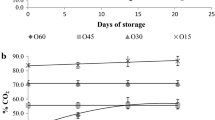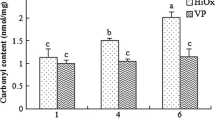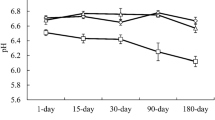Abstract
We aimed to investigate the effect of high-oxygen modified atmosphere packaging (MAP) on cooked meat products with respect to tenderness, lipid oxidation, and microbial growth. Pork meat was boiled and packaged using air packaging, vacuum packaging, and high-oxygen MAP (80% O2 + 20% CO2, 80% O2 + 20% N2, and 80% O2 + 10% CO2 + 10% N2). The acid value, peroxide value, thiobarbituric acid value, and aerobic bacterial counts were monitored during a 15-day storage period at 4 °C. Among the five different types of packaging, MAP (80% O2 + 20% N2) showed the smallest increase in shear force (from 14.01 to 20.52 N) and the lowest aerobic bacterial count (3.68 lg CFU/g). Acid values were the lowest for MAP with 80% O2 + 20% N2 and air packaging after 15 days of storage. High-oxygen MAP with 80% O2 + 20% N2 is, therefore, recommended for packaging cooked meat.





Similar content being viewed by others
References
K.W. McMillin, Where is MAP going? A review and future potential of modified atmosphere packaging for meat. Meat Sci. 80(1), 43–65 (2008)
S. Eilert, New packaging technologies for the 21st century. Meat Sci. 71(1), 122–127 (2005)
B. Day, High oxygen modified atmosphere packaging for fresh prepared produce. (Postharvest News and Information, UK, 1996)
L. Jacxsens, F. Devlieghere, C. Van der Steen, J. Debevere, Effect of high oxygen modified atmosphere packaging on microbial growth and sensorial qualities of fresh-cut produce. Int. J. Food Microbiol. 71(2), 197–210 (2001)
D. Zagory, A.A. Kader, Modified atmosphere packaging of fresh produce. Food Technol. 42(9), 70–77 (1988)
O.J. Caleb, P.V. Mahajan, FA-J Al-Said, U.L. Opara, Modified atmosphere packaging technology of fresh and fresh-cut produce and the microbial consequences—a review. Food Bioprocess Tech. 6(2), 303–329 (2013)
K. Murphy, M. O’Grady, J. Kerry, Effect of varying the gas headspace to meat ratio on the quality and shelf-life of beef steaks packaged in high oxygen modified atmosphere packs. Meat Sci. 94(4), 447–454 (2013)
V.C. Resconi, A. Escudero, J.A. Beltrán, J.L. Olleta, C. Sañudo, M. Campo, Color, lipid oxidation, sensory quality, and aroma compounds of beef steaks displayed under different levels of oxygen in a modified atmosphere package. J. Food Sci. 77(1), S10–S18 (2012)
M. Vitale, M. Pérez-Juan, E. Lloret, J. Arnau, C. Realini, Effect of aging time in vacuum on tenderness, and color and lipid stability of beef from mature cows during display in high oxygen atmosphere package. Meat Sci. 96(1), 270–277 (2014)
X. Li, G. Lindahl, G. Zamaratskaia, K. Lundström, Influence of vacuum skin packaging on color stability of beef longissimus lumborum compared with vacuum and high-oxygen modified atmosphere packaging. Meat Sci. 92(4), 604–609 (2012)
J. Stoops, S. Ruyters, P. Busschaert, R. Spaepen, C. Verreth, J. Claes, B. Lievens, L. Van Campenhout, Bacterial community dynamics during cold storage of minced meat packaged under modified atmosphere and supplemented with different preservatives. Food Microbiol. 48, 192–199 (2015)
J.M. Lyte, J.F. Legako, J.N. Martin, L. Thompson, K. Surowiec, J. Brooks, Volatile compound characterization of modified atmosphere packaged ground beef held under temperature abuse. Food Control 59, 1–6 (2016)
M.G. O’Sullivan, S. Le Floch, J.P. Kerry, Resting of MAP (modified atmosphere packed) beef steaks prior to cooking and effects on consumer quality. Meat Sci. 101, 13–18 (2015)
E. Jääskeläinen, J. Hultman, J. Parshintsev, M.-L. Riekkola, J. Björkroth, Development of spoilage bacterial community and volatile compounds in chilled beef under vacuum or high oxygen atmospheres. Int. J. Food Microbiol. 223, 25–32 (2016)
P. Zakrys-Waliwander, M. O’sullivan, E. O’neill, J. Kerry, The effects of high oxygen modified atmosphere packaging on protein oxidation of bovine M. longissimus dorsi muscle during chilled storage. Food. Chem. 131(2), 527–532 (2012)
S. Jongberg, J. Wen, M.A. Tørngren, M.N. Lund, Effect of high-oxygen atmosphere packaging on oxidative stability and sensory quality of two chicken muscles during chill storage. Food Packag. Shelf Life 1(1), 38–48 (2014)
Y. Bao, P. Ertbjerg, Relationship between oxygen concentration, shear force and protein oxidation in modified atmosphere packaged pork. Meat Sci. 110, 174–179 (2015)
J.M. Behrends, W.B. Mikel, C.L. Armstrong, M.C. Newman, Color stability of semitendinosus, semimembranosus, and biceps femoris steaks packaged in a high-oxygen modified atmosphere. J. Anim. Sci. 81(9), 2230 (2003)
M. Jakobsen, G. Bertelsen, Colour stability and lipid oxidation of fresh beef. Development of a response surface model for predicting the effects of temperature, storage time, and modified atmosphere composition. Meat Sci. 54(1), 49 (2000)
General Administration of Quality Supervision IaQotPsRoCA, Standardization Administration of China Animal and vegetable fats and oils-determination of peroxide value. vol GB/T 5538–2005/ISO 3960: 2001. (Standardpress of China, Chinese, 2005)
V.C. Witte, G.F. Krause, M.E. Bailey, A new extraction method for determining 2-thiobarbituric acid values of pork and beef during storage. J Food Sci 35(5), 582–585 (1970)
K. Bouma, R.C. Schothorst, Identification of extractable substances from rubber nettings used to package meat products. Food Addit. Contam. 20(3), 300 (2003)
L.J. Bratzler, Measuring the tenderness of meat by means of a mechanical shear. An Acad. Bras Cienc 86(2), 633–648 (2010)
L. Vermeiren, F. Devlieghere, I. Vandekinderen, U. Rajtak, J. Debevere, The sensory acceptability of cooked meat products treated with a protective culture depends on glucose content and buffering capacity: A case study with Lactobacillus sakei 10A. Meat Sci. 74(3), 532–545 (2006)
P. Zakrys-Waliwander, M. O’sullivan, P. Allen, E. O’Neill, J. Kerry, Investigation of the effects of commercial carcass suspension (24 and 48 h) on meat quality in high oxygen modified atmosphere packed beef steaks during chill storage. Food research international 43(1), 277–284 (2010)
F. Shahidi, U.N. Wanasundara, C.C. Akoh, D.B. Min, Methods for measuring oxidative rancidity in fats and oils. Food Lipids: Chemistry, Nutrition and Biotechnology, (2002)
C.M. Messina, G. Bono, G. Renda, L. La Barbera, A. Santulli, Effect of natural antioxidants and modified atmosphere packaging in preventing lipid oxidation and increasing the shelf-life of common dolphinfish (Coryphaena hippurus) fillets. LWT Food Sci. Technol. 62(1), 271–277 (2015)
J.M. Cayuela, M.D. Gil, S. Bañón, M.D. Garrido, Effect of vacuum and modified atmosphere packaging on the quality of pork loin. Eur. Food Res. Technol. 219(4), 316–320 (2004)
F. Monahan, Oxidation of lipids in muscle foods: fundamental and applied concerns. Antioxidants in muscle foods. Nutritional strategies to improve quality. (Wiley, New York, 2000)
W. Vyncke, Direct determination of the thiobarbituric acid value in trichloracetic acid extracts of fish as a measure of oxidative rancidity. Chemische Revue über die Fett- und Harz-Industrie. 72(12), pp. 1084–1087 1969
R. Guillén-Sans, M. Guzmán-Chozas, The thiobarbituric acid (TBA) reaction in foods: a review. Crit. Rev. Food Sci. Nutr. 38(4), 315–350 (1998)
E. Caplice, G.F. Fitzgerald, Food fermentations: role of microorganisms in food production and preservation. Int. J. Food Microbiol. 50(1–2), 131–149 (1999)
Y. Rao, B. Xiang, X. Zhou, Z. Wang, S. Xie, J. Xu, Quantitative and qualitative determination of acid value of peanut oil using near-infrared spectrometry. J. Food Eng. 93(2), 249–252 (2009)
Z. Ying, Y. Lei, Y. Zu, X. Chen, F. Wang, L. Fang, Oxidative stability of sunflower oil supplemented with carnosic acid compared with synthetic antioxidants during accelerated storage. Food. Chem. 118(3), 656–662 (2010)
F. Liu, Q. Xu, R.T. Dai, Y.Y. Ni, Effects of natural antioxidants on colour stability, lipid oxidation and metmyoglobin reducing activity in raw beef patties. Acta Scientiarum Polonorum Technologia Alimentaria 14(1), 37 (2015)
W.J. Yan, J.Y. Cui, R.T. Dai, H.F. Wang, X.M. Li, Effects of dense phase carbon dioxide on quality and physical-chemical properties of chilled pork. Trans. Chin. Soc. Agric. Eng. 26(7), 346–350 (2010)
Funding
This study was supported by Major projects of natural science research in Universities of Jiangsu Province (13KJA550002) and sponsored by the Qing Lan Project.
Author information
Authors and Affiliations
Corresponding author
Ethics declarations
Conflict of interest
The authors declare that they have no conflict of interest.
Electronic supplementary material
Below is the link to the electronic supplementary material.
Rights and permissions
About this article
Cite this article
Wang, W., Sun, Ye. & Ma, L. Effect of high-oxygen modified atmosphere packaging on the tenderness, lipid oxidation and microbial growth of cooked pork. Food Measure 12, 395–402 (2018). https://doi.org/10.1007/s11694-017-9652-9
Received:
Accepted:
Published:
Issue Date:
DOI: https://doi.org/10.1007/s11694-017-9652-9




